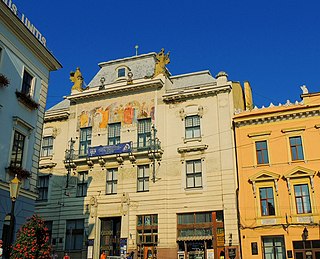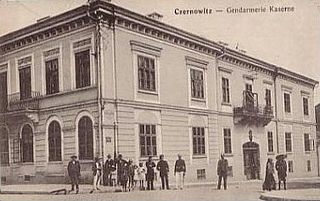
Bukovina is a historical region, variously described as part of either Central or Eastern Europe. The region is located on the northern slopes of the central Eastern Carpathians and the adjoining plains, today divided between Romania and Ukraine.

Chernivtsi Oblast, also referred to as Chernivechchyna (Чернівеччина), is an oblast (province) in western Ukraine, consisting of the northern parts of the historical regions of Bukovina and Bessarabia. It has an international border with Romania and Moldova. The region spans 8,100 square kilometres (3,100 sq mi). The oblast is the smallest in Ukraine both by area and population. It has a population of 890,457, and its administrative center is the city of Chernivtsi.

Chernivtsi is a city in southwestern Ukraine on the upper course of the Prut River. Formerly the capital of the historic region of Bukovina, which is now divided between Romania and Ukraine, Chernivtsi serves as the administrative center for the Chernivtsi Raion, the Chernivtsi urban hromada, and the oblast itself. In 2022, the Chernivtsi population, by estimate, is 264,298, and the latest census in 2001 was 240,600.

Gura Humorului is a town in Suceava County, northeastern Romania. It is situated in the historical region of Bukovina.

Traian Popovici was a Romanian lawyer and mayor of Cernăuți during World War II, known for saving 20,000 Jews of Bukovina from deportation.
The history of the Jews in Bessarabia, a historical region in Eastern Europe, dates back hundreds of years.

The Hertsa region, also known as the Hertza region, is a region around the town of Hertsa within Chernivtsi Raion in the southern part of Chernivtsi Oblast in southwestern Ukraine, near the border with Romania. With an area of around 304 km2 (117 sq mi), it has a population of about 32,300 people, 93% of whom are ethnic Romanians.

The history of the Jews in Romania concerns the Jews both of Romania and of Romanian origins, from their first mention on what is present-day Romanian territory. Minimal until the 18th century, the size of the Jewish population increased after around 1850, and more especially after the establishment of Greater Romania in the aftermath of World War I. A diverse community, albeit an overwhelmingly urban one, Jews were a target of religious persecution and racism in Romanian society from the late-19th century debate over the "Jewish Question" and the Jewish residents' right to citizenship, to the genocide carried out in the lands of Romania as part of the Holocaust. The latter, coupled with successive waves of aliyah, has accounted for a dramatic decrease in the overall size of Romania's present-day Jewish community.

The history of the Jews in Moldova reaches back to the 1st century BCE, when Roman Jews lived in the cities of the province of Lower Moesia. Bessarabian Jews have been living in the area for some time. Between the 4th-7th centuries CE, Moldova was part of an important trading route between Asia and Europe, and bordered the Khazar Khaganate, where Judaism was the state religion. Prior to the Second World War, violent antisemitic movements across the Bessarabian region badly affected the region's Jewish population. In the 1930s and '40s, under the Romanian governments of Octavian Goga and Ion Antonescu, government-directed pogroms and mass deportations led to the concentration and extermination of Jewish citizens followed, leading to the extermination of between 45,000-60,000 Jews across Bessarabia. The total number of Romanian and Ukrainian Jews who perished in territories under Romanian administration is between 280,000 and 380,000.

Hotin County was a county in the Principality of Moldavia (1359–1812), the Governorate of Bessarabia (1812–1917), the Moldavian Democratic Republic (1917–1918), and the Kingdom of Romania.

Kitsman is a city located in Chernivtsi Raion, Chernivtsi Oblast, in the historical region of Bukovina of western Ukraine. It hosts the administration of Kitsman urban hromada, one of the hromadas of Ukraine. The town is about 20 km (12 mi) northwest from Chernivtsi on the road to Zalishchyky. Population: 6,049.

The Bukovina Germans, also known and referred to as Buchenland Germans, or Bukovinian Germans, are a German ethnic group which settled in Bukovina, a historical region situated at the crossroads of Central and Eastern Europe, during the modern period. They are part of the larger group of Romanian Germans since the early 20th century, when they were initially living in the Kingdom of Romania.

Gheorghe Flondor was Romanian politician who served as Royal Resident of Ținutul Suceava from February 7, 1939 to September 23, 1940.

Cernăuți County was a county (județ) of Romania, in Bukovina, with the capital city at Cernăuți. The area was incorporated into the Soviet Union in 1940 and again in 1944, and has been part of Ukraine since 1991.

Storojineț County was a county (județ) of Romania, in Bukovina, with the capital city at Storojineț. The area was incorporated into the Soviet Union in 1940 and again in 1944, and has been part of Ukraine since 1991.
Corneliu Calotescu was a Romanian major-general during World War II.
The Democratic Union Party was a political group in Romania, one of the political forces which claimed to represent the ethnic Romanian community of Bukovina province. The PDU was active in the wake of World War I, between 1919 and 1923, having for its leader the historian and nationalist militant Ion Nistor. It was formed by Nistor and other activists who wrote for the regional periodical Glasul Bucovinei, and, as a consequence, the party members were commonly referred to as Glasiști ("Glas-ists").

The Bukovina Governorate was an administrative unit of Romania during World War II.

The Bessarabia Governorate was an administrative unit of Romania during World War II.

The Jewish Community in Chernivtsi was the largest Jewish Community in all of Bukovina, in what is now Romania and Ukraine. At its peak in 1941, more than 45 thousand Jews lived in Chernivtsi.
















